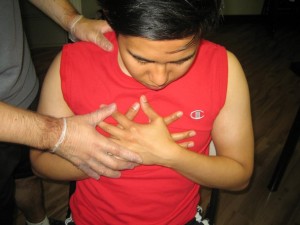A torn rib cartilage is caused by trauma or overstretching of the junction between the bones and cartilage of the rib cage. The rib cage is composed of the bone and cartilage which is a firm tissue that is more elastic than bones. Cartilage that is connected to the front area of the ribs makes the chest expand with movement and breathing.
A torn rib cartilage causes severe pain especially immediately after the injury. Pain can persist for weeks or even months depending on the severity of the condition.
Symptoms of torn rib cartilage
- The main muscles used for breathing or the diaphragm which is connected to the lower ribs causes severe pain when coughing, breathing and sneezing.
Take plenty of rest for at least 6 weeks. Avoid performing strenuous activities and participating in sports activities for fast healing of the condition. - Regular movements such as twisting or expansion of the rib cage can result to pain.
- Bruising due to a strong blow to the chest
- Swelling of the affected area.
- Breathing becomes shallow by trying to lessen the pain by avoiding taking a deep breath
- A clicking, popping or grinding sound can be heard at the time of the injury
If experiencing pain in the chest with nausea, sweating, dizziness and arm or jaw pain which is not caused by injury, it should be treated immediately.
Treatment
- Take plenty of rest for at least 6 weeks. Avoid performing strenuous activities and participating in sports activities for fast healing of the condition.
- Apply a cold pack on the early stages of the injury to reduce the inflammation for at least 20-30 minutes every 3-4 hours. Do not place the pack directly on the skin.
- Use a rib belt to compress the rib cage to prevent unnecessary movements when breathing, laughing or coughing. This is an elastic strap about 8 inches wide that encircles the rib cage. It also lessens the pain during regular movements.
- Apply heat to lessen the pain and discomfort in the chest. Heat can be in the form of a heating pad or a warm towel applied on the chest for at least 10-15 minutes several times every day. Heat increases the flow of blood in the area and promotes fast healing of the condition.
- Take the prescribed pain medications such ibuprofen to lessen the inflammation and pain.
- Seek the help of the physical therapist for some rehabilitation exercises to restore normal movements without aggravating the condition.
Tips
- Avoid sleeping on the stomach
- Avoid performing activities that result to hyper-extension of the lumbar area.
- Avoid staying in a position for long periods of time. Take a break by standing up and stretch the body as much as possible.
More Information
The details posted on this page on a torn rib cartilage is for learning purposes only. To learn to recognize and manage cartilage injuries, enroll in a first aid course with one of our training providers.

